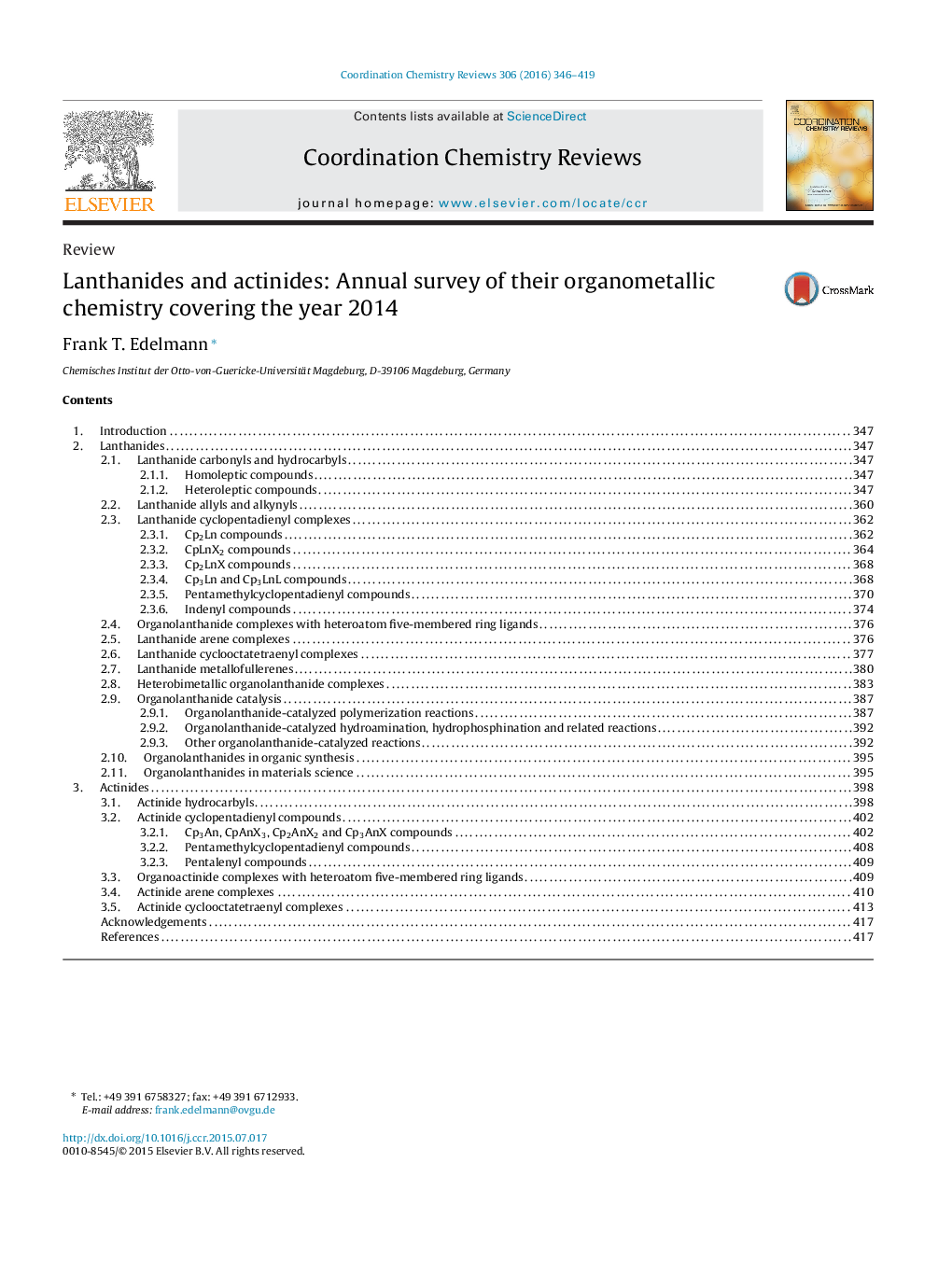| کد مقاله | کد نشریه | سال انتشار | مقاله انگلیسی | نسخه تمام متن |
|---|---|---|---|---|
| 1299630 | 974239 | 2016 | 74 صفحه PDF | دانلود رایگان |
• Solvent-free and mechanochemical syntheses have been employed in organo-f-element chemistry.
• The metallomacrocyclic [(TpMe2)Y(μ-N,C-Im)(η2-N,C-Im)]6 has been prepared.
• Unusual clusters were isolated from Cp*2Ln(THF)2 (Ln = Sm, Eu, Yb) and SO2, As4S4, and As3S4.
• An actinide metallacyclopropene and a base-free thorium imido complex have been reported.
• The first uranium(II) arene complex, K[(2.2.2-crypt)][{(Ad,MeArO)3mes}U], has been reported.
This review summarizes the progress in organo-f-element chemistry during the year 2014. An unbroken trend for many years which continued into 2014 was the investigation of highly reactive lanthanide alkyl complexes supported by non-cyclopentadienyl ligands (e.g. amidinates, aminopyridinates, aminophenolates, pincer ligands, etc.). Many of these complexes found useful applications in homogeneous catalysis. Very high reactivity was demonstrated for a base-free scandium-terminal imido complex. Other notable highlights in organolanthanide chemistry are e.g. the successful synthesis of rare non-Cp containing lanthanide silyl complexes, the molecular structure of the hexanuclear 24-membered metallomacrocyclic compound [(TpMe2)Y(μ-N,C-Im)(η2-N,C-Im)]6, and the unusual mechanochemical (ball-milling) synthesis of the unsolvated tris(allyl) scandium complex [1,3-(SiMe3)2C3H3]3Sc. Bent metallocenes containing Cp*2Ln units continue to be the working horses in organolanthanide chemistry. Recent studies in this field included e.g. the discovery of single-molecule magnet behavior of Cp*2Ln(BPh4) (Ln = Tb, Dy) and a novel solvent-free synthesis of the hydride Cp*2Y(μ-H)YHCp*2 from H2 and solid Cp*2Y(allyl). Unprecedented main-group derivatives have been isolated from reactions of the divalent metallocenes Cp*2Ln(THF)2 (Ln = Sm, Eu, Yb) with SO2, As4S4, and As3S4. The study of organo-rare-earth-based single-molecule magnets (SMMs) and single-ion magnets (SIMs) continues to be an exciting topic in organolanthanide chemistry. Cyclooctatetraenyl (COT) complexes play a prominent role in that respect. Numerous exciting results have again been published in 2014 in the field of endohedral lanthanide metallofullerenes. Increasing importance was observed for heterobimetallic organolanthanide compounds, including those comprising direct lanthanide-transition metal bonds. In organolanthanide catalysis, the most important results have been published in the field of diene (especially isoprene) polymerization. The use of volatile ring-substituted tris(cyclopentadienyl)lanthanide as precursors in materials science continued to be an area of active research. Ca. 21% of all relevant papers published in 2014 were in the field of organoactinide chemistry, which continues to produce exciting results. Once again, major achievements have been made in the chemistry of thorium and uranium carbene complexes containing either N-heterocyclic carbene (NHC) ligands or chelating carbene ligands such as C(PPh2NSiMe3)2 (BIPMTMS). The (1,2,4-tBu3C5H2)2Th platform enabled the synthesis and reactivity study of several unusual thorium metallocenes, including an actinide metallacyclopropene and a base-free thorium imido complex. Gas/solid reactions involving H2 and CO2 with the solid metallocenes Cp*2UMe2 and Cp*2U(allyl)2 in the absence of solvent provided an innovative method to make organouranium complexes. With K[(2.2.2-crypt)][{(Ad,MeArO)3mes}U] a genuine uranium(II) monoarene complex with a 5f4 electronic configuration has been isolated.
Journal: Coordination Chemistry Reviews - Volume 306, Part 1, 1 January 2016, Pages 346–419
